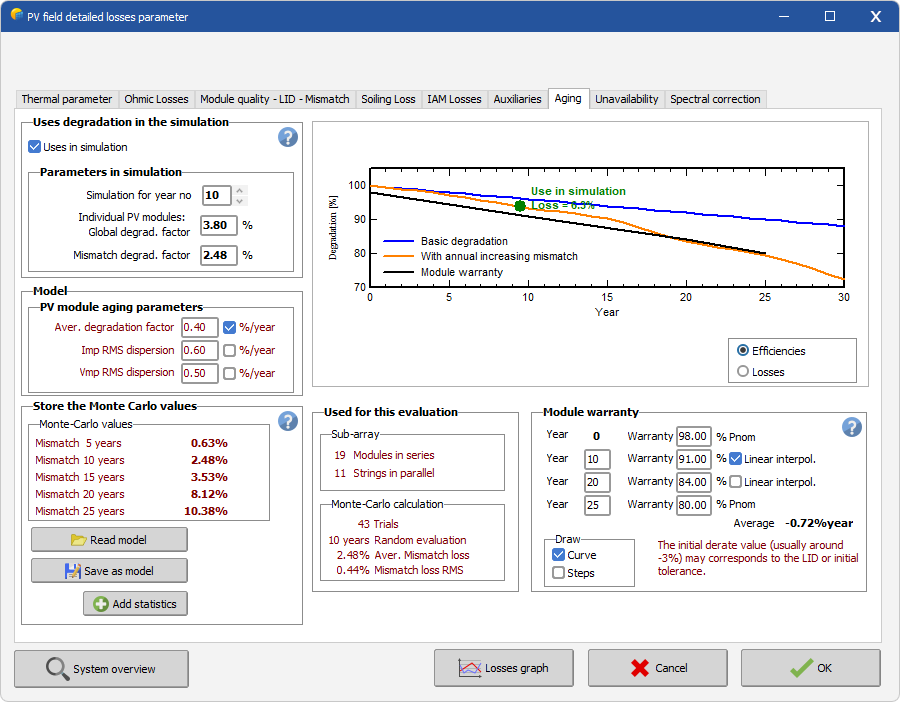|
<< Click to Display Table of Contents >> Ageing, PV modules degradation |
  
|
|
<< Click to Display Table of Contents >> Ageing, PV modules degradation |
  
|
The main parts of a PV system subjected to ageing are:
- The PV module itself (long-term degradation),
- The increasing mismatch between modules, which don't degrade all at a same rate.
- The batteries in systems with storage (should be replaced, sometimes several times during the life of a system),
- Eventually the inverters, which have sometimes to be repaired or replaced,
- Elements of the wiring, lightning surge protectors, etc.
The PV module degradation gives rise to a progressive loss of efficiency, which we will characterize by a "Degradation Loss factor".
The simulation may be run for a specified year of the PV system life, and will apply the degradation for this year. The degradation means a decrease of the PV array yield. It may sometimes have some "positive" effect on the full system behavior, which may lessen a little bit the degradation effects. This may be namely a diminution of the overpower losses when the inverter is strongly undersized.
Guaranteed and Average degradation rate
People often use the Manufacturer's warranty specification as loss reference when designing the degradation of a PV systems, which is usually a loss of efficiency of around 20% after 25 years.
This is not the right way.
The Manufacturer's warranty should be understood as a lower limit for any individual PV module.
In these curves, the initial loss (of the order of 3%) should be considered as the LID, or initial Power possible deficit (tolerance, factory measurement uncertainty). Therefore the annual guaranteed lower limit diminution rate is the slope of this curve. In our example (-3% initial, -20% after 25 years), this means a rate of -0.68%/year. But this is not the degradation rate of the full array.
In this tool we define an average degradation rate (for a set of modules). This loss value may be much lower than this guaranteed limit. Some experimental studies mention degradation rates of the order of -0.3%/year measured as an average on several modules (and measured with very old modules manufactured in the years 80-90, with old technologies). Long-term degradation rate measurements are relatively scarce.
NB: Nothing prevents to limit the lifetime of the PV modules to 25 years. A well-maintained PV system may probably stay operational over much longer periods.
Mismatch evolution
Moreover, all the modules will not degrade with the same rate. If you have a distribution of loss rates around this average, this will produce an additional loss due to mismatch, increasing with time.
In PVsyst, you can specify the RMS of this distribution (supposed gaussian), and the program will evaluate the mismatch as function of the age of the system. This calculation is performed using a Monte-Carlo method (choice of a great number of random distributions), with the following hypothesis:
- the degradation rate of each module is constant over the years,
- the distribution choice is limited to 2 sigmas (95% of the hits); because high discrepancies result in very high mismatch losses.

NB: We don't have much references about the average module degradation.
A fortiori, we don't have any information about the real ageing discrepancies between modules (RMS distributions).
Now the warranty should normally apply to any module of the sample. Therefore if we assume that it is applicable to 95% of the modules, the sum "Degradation factor" + 2 * "RMS dispersion" should in principle not exceed the slope of 0.8% of the warranty. This is not the case in our example.
NB: The simulation for a given year takes the average loss calculated mid year. For example for the 10th year of operation, the ageing loss factor will be calculated over 9.5 years.
For the usual simulations of PVsyst (first year) we should indeed consider the degradation after 6 months (0.2% in our example). This is usually neglected.